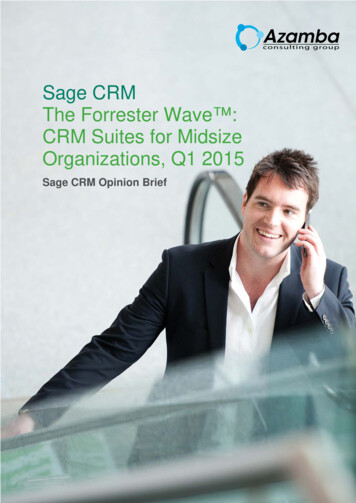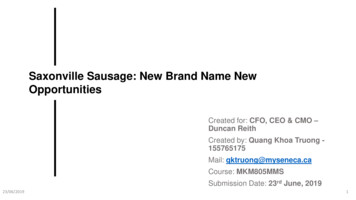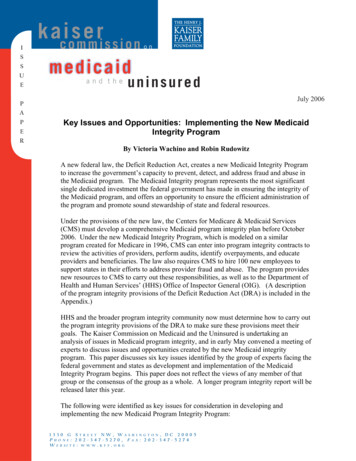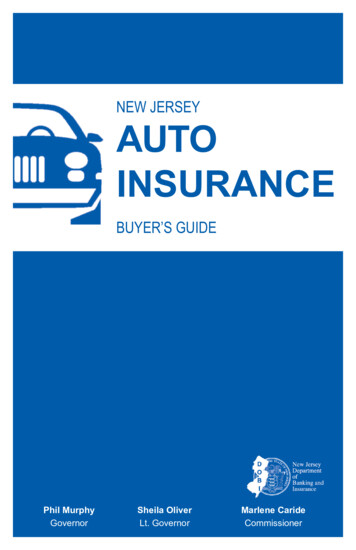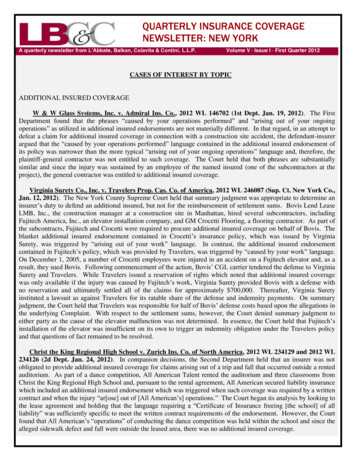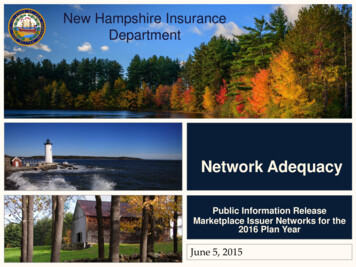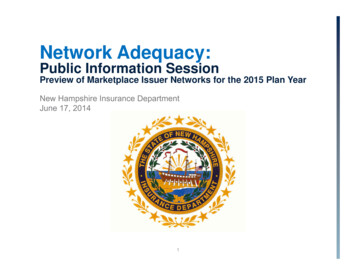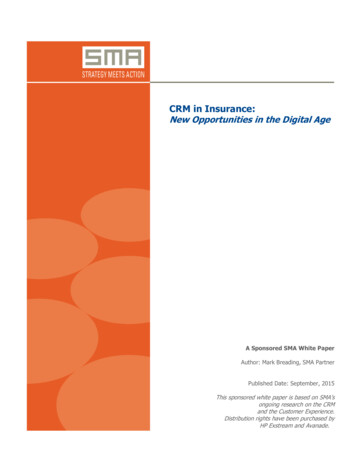
Transcription
CRM in InsuranceCRM in Insurance:New Opportunities in the Digital AgeA Sponsored SMA White PaperAuthor: Mark Breading, SMA PartnerPublished Date: September, 2015This sponsored white paper is based on SMA’songoing research on the CRMand the Customer Experience.Distribution rights have been purchased byHP Exstream and Avanade.A Sponsored SMA White Paper 2015 SMA All Rights Reservedwww.strategymeetsaction.comPage 1
CRM in InsuranceTable of ContentsAbout ThisWhite PaperThis white paper isbased on SMA insightsfrom working withinsurers on strategiesand on a survey of 73North American insurers.The survey included bothproperty/casualty andlife/annuity segments,with companies of allsizes participating.Respondents were a mixof business and ITexecutives andprofessionals.Relationship Management in the Digital Age3Trends and Current Status of CRM Solutions In InsurancePlans for New CRM Solutions In InsuranceWhy are Insurers Investing in CRM Now?What CRM Capabilities are Insurers Seeking?5Types of Information and SystemsCurrent and Planned CapabilitiesKey Technologies for CRMHow are Insurers Approaching CRM Implementations?8Challenges Faced by InsurersApproaches to CRMSMA Call to Action8About Strategy Meets Action9About the Sponsors10AvanadeHP ExstreamThe content of this SMA White Paper is based on a study conducted in second quarterof 2015 by SMA. The results are based on the participation of 73 insurers in NorthAmerica. HP Exstream and Avanade are sponsoring this white paper and havepurchased full distribution rights.A Sponsored SMA White Paper 2015 SMA All Rights Reservedwww.strategymeetsaction.comPage 2
CRM in InsuranceRelationship Management in the Digital AgeThe insurance industry was once dominated by policy-centric, inside-out thinking.Relationships were simple – a policyholder was matched with a policy and perhaps anagent/producer. Much of the executive focus and corresponding technology investmentwas designed to improve operational efficiencies and manage the porfolio of risks.Those days are rapidly disappearing. Most insurers have done a significant reorientation around customers, taking the outside-in view and seeking to gain and act ona deeper understanding of their relationships with customers, as well as agents. In fact,insurers ranked customer engagement and experience as the number one strategicinitiative in 2015, with 85% of insurers claiming to have major initiatives in progress.New SMA researchshows that there is anew wave of CRMimplementations andenhancements underway in the insuranceindustry.About one-third of NorthAmerican insurers havemajor initiatives inprogress or planned,with 13% planning newCRM installs and another17% budgeting formajor enhancements.In an earlier age, many insurers (especially larger companies), implemented complextechnology solutions to manage relationships. Many of these CRM (customerrelationship management) solutions from 10-15 years ago are still in place. Todayrelationship management is considerably more involved and offers a wider range ofadvantages, causing many companies to consider whether to extend existing systems orimplement new CRM solutions. Technology to manage relationships withagents/brokers/producers has become more important. New types of informationbeyond contact information, products, and family relationships are becoming necessaryto truly understand the customer (including location characteristics, communicationpreferences, social networks, and a historical view).Many insurers are now aggressively working toward becoming digital enterprises. Thismeans that more content is captured, created, managed, and delivered digitally througha broader set of channels, leveraging modern solutions such as customercommunications management (CCM). Interactions are being customized, personalized,and informed by the context of the interaction, resulting in a greater awareness of thepolicyholders and their relationships with the company (and others). For this reason,CRM solutions have once again come to the forefront as vital components of anyinsurer’s strategy.Trends and Current Status of CRM Solutions In InsuranceSMA research provides strong evidence to support the contention that insurers areinvesting in implementing and enhancing CRM solutions. The trend over that last threeyears is telling. In 2013, 1% of North American insurers implemented new CRMsystems; in 2014 that percentage rose to 4%. Plans for 2015 indicate that 13% ofinsurers have new CRM implementations underway, while another 17% have budgetedfor major enhancements. This means that almost one-third of North American insurershave key initiatives related to CRM solutions. In fact, 39% plan annual increases in theCRM budget of over 5% per year through 2018, with 11% increasing budgets by morethan 10% annually.There are distinct differences in the usage of CRM solutions based on the size of theinsurer and line of business. Figure 1 shows the percentage of companies that havenever implemented a formal CRM solution and have no current plans to change coursevs. those that have CRM or are in planning stages. Not surprisingly, more of the smallercompanies do not have CRM systems. In addition, the penetration is higher forA Sponsored SMA White Paper 2015 SMA All Rights Reservedwww.strategymeetsaction.comPage 3
CRM in InsuranceLife/Annuity companies than Property/Casualty, primarily due to the fact that many ofthe small (Tier 4) companies are regionally-based P&C companies (such as farmmutuals).Figure 1. Current State of CRM Systems in Insurance in North AmericaSource: SMA Research 2015, CRM in Insurance, n 73Plans for New CRM Solutions In InsuranceOver the next 12-18 months, a significant percentage of insurers plan to implement newCRM systems, with a wide variance by size. Approximately 6% of insurers over 1B inpremiums plan new systems, while a huge 29% of mid-tier companies ( 250M - 1B)plan new systems. From an LOB viewpoint, 18% of P&C and 13% of L&A insurers plannew solutions. These systems may be either a new, common CRM system handling awide variety of types of parties and relationships, or additional systems beyond the coreCRM that are more focused, such as agent or broker relationship management systems.Why are Insurers Investing in CRM Now?The rapid movement to a digital, mobile world and the expectations of customers andagents are the business drivers motivating insurers to invest in CRM. But what doinsurers say are the main objectives of implementing new systems or extending existingCRM systems?Most insurers cite improving sales, better managing relationships, improving thecustomer experience, and increasing loyalty as primary reasons for investing in CRMnow. However, a big difference emerges when comparing objectives of insurers ofdifferent size categories. Those over 1B list enhancing customer and agent/producerexperiences as two of the top five reasons for investing or reinvesting in CRM. Smallerinsurers certainly have those objectives in mind as well, but improving profitability andmanaging expenses are ranked higher in the priority scheme for CRM solutions.A Sponsored SMA White Paper 2015 SMA All Rights Reservedwww.strategymeetsaction.comPage 4
CRM in InsuranceOther key reasons for investing in CRM include understanding the pipeline, personalizingmarketing, and improving cross-sell and up-sell capabilities. Our expectation is thatwhen new CRM solutions are implemented or existing ones are enhanced, insurers willbe able to realize the basic objectives of improving sales, relationships, and experiences.This has the potential to deliver significant advantages, but is just the springboard forfurther growth. The next wave of objectives – personalization, focus on cross-sell/upsell, and pipeline management will provide new ways to improve those experiences anddrive sales and loyalty, which are the ultimate objectives.What CRM Capabilities are Insurers Seeking?CRM solutions, in place or in process, provide a wide variety of functional capabilitiesand technologies to the insurer. It is vital to understand the different types of systems,information managed, and capabilities available, and to identify the priorities thatinsurers are placing on those capabilities.Types of Information and SystemsIdeally, all types of relationships with customers and other parties are stored, tracked,and managed in a common CRM solution. Unfortunately, this is rarely the case,although many in the industry are moving closer to this ideal. When evaluating thecategories of parties that should be covered in CRM, five “Ps” should be considered:prospects, policyholders, producers, partners, and providers. Today, especially withmodern or new systems, the central CRM solution tends to have information about threemain communities – prospects, policyholders, and producers. For business partners andproviders (suppliers), it is still more typical for their information to be managed viadifferent mechanisms. CRM for Prospects, Policyholders, and Producers: Many insurers still haveseparate technology solutions to manage these three groups. Information aboutprospects is often stored in prospect or campaign management systems, andmanaged by marketing and distribution. Policyholder information is central to themain CRM system, with key information retrieved from core policy, billing, and claimsystems as well. The distribution/channel management functional areas of thebusiness often have their own databases and systems to manage their relationshipsand interactions with producers and agents. However, there is a distinct trend toconsolidate relationship information about all three of these parties into thecommon CRM system. CRM for Partners and Providers: Business partners, such as independentadjusters, law firms, or loss control engineering experts are usually managed byseparate technology solutions, and spreadsheets are most commonly used to trackthat information. The second most common approach is to establish a formalpartner management system. Providers, such as those for supplies, office furniture,and technology are the least formally managed, from a CRM perspective. They aremost often managed via financial systems for suppliers or via spreadsheets. Intheory there is value in understanding these relationships in a CRM context as well,A Sponsored SMA White Paper 2015 SMA All Rights Reservedwww.strategymeetsaction.comPage 5
CRM in Insurancebut there is not a strong incentive to incorporate either partners or providers intothe common CRM.The types of information stored in CRM systems are continuing to expand. While theoriginal intent of CRM was to gain a more complete understanding of the relationshipsassociated with products and people, the current trend is to incorporate informationabout interactions/communications, location, social networks, delivery preferences, andother information.Current and Planned CapabilitiesThe current capabilities in CRM systems are focused on fundamental relationship relatedinformation as described above. As seen in Figure 2, the top capabilities today aremanaging information about contacts, coverages, and products, plus information aboutrecent transactions and account balances.Figure 2. Current and Planned Capabilities for CRM Systems for PolicyholdersSource: SMA Research 2015, CRM in Insurance, n 73The focus shifts when considering new capabilities planned for the next 12-18 months.It is not just about the information, but more about how to access and leverage it. Thenumber one capability planned for CRM solutions related to policyholders is gainingmore insight into the sales stage – understanding the customer journey that anindividual or business prospect/customer is taking and knowing exactly where they arein that journey – to provide context for each interaction. Mobile access is high oneveryone’s list since the front line individuals using CRM systems are more often usingmobile devices in their daily jobs, especially those in the field dealing directly withcustomers. A third major capability sought by insurers is a 360 view of the customer,which is vital as more companies seek to move toward omni-channel operations andimprove the customer experience.A Sponsored SMA White Paper 2015 SMA All Rights Reservedwww.strategymeetsaction.comPage 6
CRM in InsuranceKey Technologies for CRMThere are many specific technology capabilities that insurers identify as importantelements of modern CRM solutions, as indicated in Figure 3.Figure 3. Most Important Technology Capabilities for CRM(Percent of Insurers Citing)Source: SMA Research 2015, CRM in Insurance, n 73First and foremost among tech capabilities is real-time analytics, with over half of allinsurers (55%) citing this as essential. This reflects the evolution of CRM from static toreal-time, from providing a snapshot to enabling action by front line professionals. Thesecond most requested tech capability is transactional integration across all sources.This is perfectly in line with omni-channel initiatives. It is impossible to easily manageinteractions and exchange information across channels unless real-time integration atthe transaction level is in place.The second set of maturing technologies is also very important and rounds out the topfive technology capabilities expected in modern CRM solutions – those related to mobile,cloud, and collaboration. Regarding mobile technologies, insurers are looking to providea platform that supports any popular mobile device through responsive designapproaches. Cloud technologies are in the mainstream in insurance now and areparticularly popular for CRM solutions. Most insurers implementing new CRM solutionsexpect them to be cloud-based or at least provide the option of cloud, on-premises, orhybrid operations. Finally, collaboration technologies are growing in importance ascompanies look to leverage the power of CRM solutions through technologies thatidentify the right experts in real-time and connect customers, agents, and others forconversations using tools such as chat, video, and screen sharing.A Sponsored SMA White Paper 2015 SMA All Rights Reservedwww.strategymeetsaction.comPage 7
CRM in InsuranceHow are Insurers Approaching CRMImplementations?Challenges Faced by InsurersCRM is challenging. The solutions and technologies available have advanced significantlyover the years, but the technical challenges of data and integration and the businesschallenges of process redesign and training require careful planning and the advice ofexperienced professionals. Insurers have identified the most critical challenges: the firstis the quality of the data and installing/maintaining the technology is the second.Following closely behind those are two business challenges – employee/agent adoptionand training of employees and agents. These key challenges are fundamentally thesame ones that insurers faced during the initial wave of CRM implementations in the2000-2005 time frame. The difference now is that many have the benefit of learningfrom the initial implementations; there are more experienced professionals available;and the technologies to address data quality, installation, and maintenance issues arenow more sophisticated.Approaches to CRMThe CRMimplementations fromthe first wave of 10-15years ago tended to bechampioned by IT anddeployed as monolithic,on-premises solutions.This new wave of CRMsolutions is more oftendriven by senior businessexecutives andimplemented viaoutsourced and/orcloud/SaaS approaches.The CRM implementations from the first wave of 10-15 years ago tended to bechampioned by IT and deployed as monolithic, on-premises solutions. This new wave ofCRM solutions is more often driven by senior business executives and implemented viaoutsourced and/or cloud/SaaS approaches.Surprisingly, there are still insurers building bespoke CRM solutions, but the tide hasshifted, much like other areas of software, to packages and further toward cloudsolutions. For example, 50% of insurers implementing new common CRM solutions areinstalling software packages, while 36% are implementing either cloud or outsourcedsolutions. The trend is similar for CRM systems built exclusively for agents/brokers, butinsurers show a slightly higher interest in building in-house.SMA Call to ActionThe concept of CRM was introduced to the industry with great fanfare in the late 1990s.Many insurers, especially tier one companies, embarked on major multi-year, enterprisewide initiatives. That first wave met with mixed success, with gains achieved and manylessons learned. Some did not achieve the promise and the ROI predicted, while otherimplementations steadily advanced to overcome some of the initial difficulties.It is a bit of a paradox that CRM is now experiencing a resurgence. On one hand, CRMwas at one time considered by many to be too complex to be successful, especially afterthe business and technical challenges encountered in earlier years. On the other hand,the industry is now truly focused on becoming customer-centric. The intent and thestrategies have been there for many years, but now the C-level support, investment,and energy is there to make improving the customer experience a reality – and a gamechanging strategy.A Sponsored SMA White Paper 2015 SMA All Rights Reservedwww.strategymeetsaction.comPage 8
CRM in InsuranceWith customer experience taking center stage, CRM once again becomes a mandatorypre-requisite. It is difficult, if not impossible, to understand each customer and servethem real-time in a complex-channel environment without having that centralizedapproach to managing relationships.Improving the customerexperience requiresinsurers to build strongerconnections betweenCRM and CCM systems.CCM systems play a vitalrole in creating, managing, and deliveringcommunications, andshould be informed byinformation and insightsfrom modern CRMsolutions.Insurers seeking to improve the customer experience and modernize, replace, or installa new CRM system should consider the following: Understand where and how relationship information is captured, housed, andmanaged today, looking at all five “Ps” – prospects, policyholders, producers,partners, and providers. Recognize the vital role of solutions that create, orchestrate, manage, and delivercommunications, especially Customer Communications Management solutions.These systems will increasingly interact with and rely on CRM. Assess the core. Without modern policy, billing, and claims systems it will be difficultto achieve enterprise wide CRM, considering that these are the systems of recordthat manage the bulk of the transactions. Map customer journeys, and develop a plan for how to operationalize insights fromthe understanding of journey patterns. Integrate customer analytics to improve customer touch point experiences with theright message for any interface, any device, and anytime. Establish a plan, endorsed and driven from the C-suite, to implement a modern CRMsolution.These steps may seem daunting. But with sustained commitment, the right technologypartners, and a modern technology platform, CRM can fulfill its original promise andcontribute significantly to the success and growth of the company.About Strategy Meets ActionStrategy Meets Action (SMA) is dedicated to helping the business of insurancemodernize, optimize, and innovate for competitive advantage. Exclusively serving theinsurance industry, SMA blends unbiased research findings with expertise andexperience to deliver business and technology insights, research, and advice to insurersand IT solution providers. By leveraging best practices from both the managementconsulting and research advisory disciplines, we take a unique approach – offering anunrivaled set of services, including retainers, research, consulting, events, andinnovation offerings.This white paper is based on SMA’s experience, research, and insights. HP Exstream andAvanade have paid for distribution rights, and have not influenced the survey
CRM solutions have once again come to the forefront as vital components of any insurer’s strategy. . drive sales and loyalty, which are the ultimate objectives. . customers. A third major capability sought by insurers is a 360 view of the customer,
